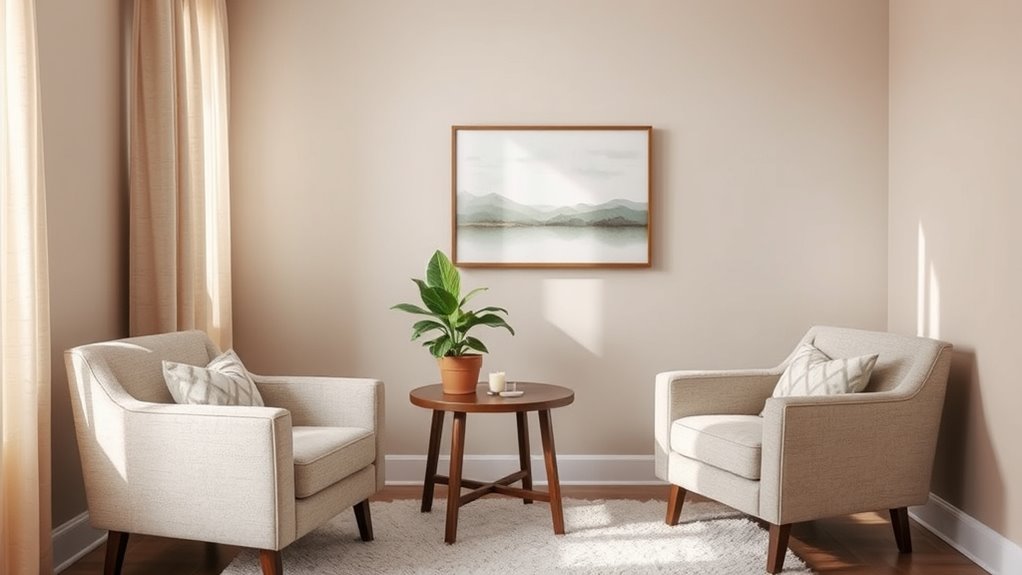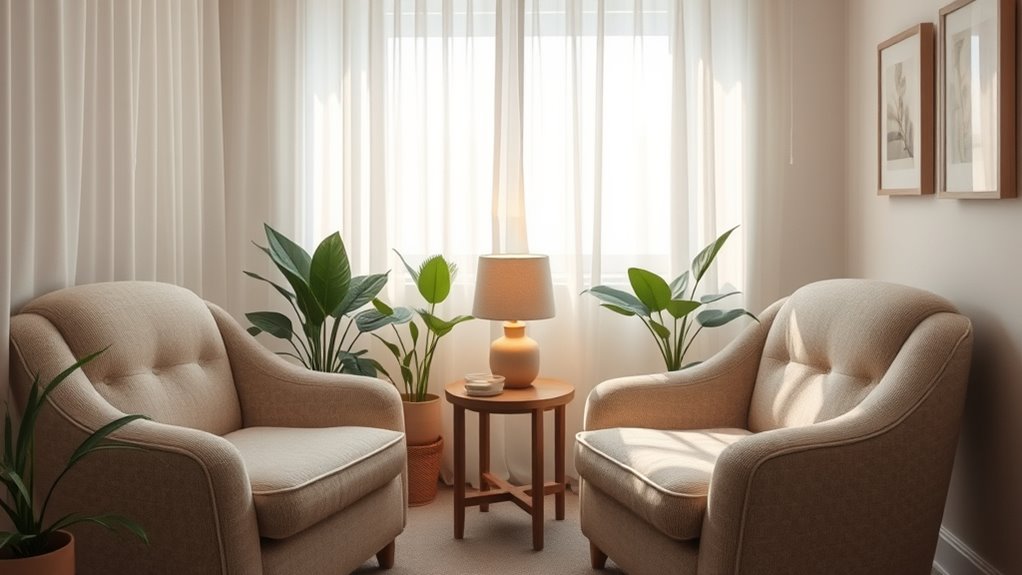To design calming retreat spaces for overstimulated seniors, choose quiet, accessible spots with gentle lighting and minimal noise. Use soft colors, comfortable furniture with rounded edges, and clutter-free decor to promote safety and relaxation. Personalize the space with familiar items like photos or favorite objects to foster comfort. Incorporate natural materials and calming sounds to enhance tranquility. If you keep exploring, you’ll discover more strategies to create truly soothing environments that support emotional well-being.
Key Takeaways
- Select quiet, accessible locations with minimal noise, natural light, and clutter-free environments to promote relaxation.
- Use soft, supportive furniture with rounded edges and gentle lighting to enhance safety and comfort.
- Incorporate natural materials, low-maintenance plants, and calming decor to evoke tranquility and familiarity.
- Personalize the space with familiar items, photos, or favorite objects to foster emotional comfort.
- Ensure the environment is safe, clutter-free, and designed to reduce overstimulation and support independence.
Understanding the Needs of Over‑Stimulated Seniors

When seniors become overstimulated, their senses can become overwhelmed, leading to anxiety, agitation, or confusion. You’ll notice signs like restlessness, loud vocalizations, or difficulty focusing. Their sensory systems might be overactive due to bright lights, loud noises, or too much movement around them. Understanding these needs means recognizing that overstimulation isn’t just about sensory input but also emotional responses. Seniors may feel frightened or frustrated when overwhelmed, so creating spaces that reduce these triggers can help calm them. Knowing their limits allows you to support their well-being better. Providing a quiet, familiar environment with minimal distractions can make a significant difference. Additionally, understanding contrast ratio and how it affects visual clarity can help in designing environments that are easier for them to process visually. By understanding what overstimulates them, you’re better equipped to design spaces that promote comfort and reduce stress.
Selecting the Ideal Location for Calm Corners

When choosing a spot for a calm corner, look for a quiet environment that minimizes noise and distractions. Make sure it’s accessible and safe, with features that support mobility and comfort. Also, consider how close it is to common areas so seniors can easily access it when needed. Incorporating low light office plants can help create a soothing atmosphere that promotes relaxation and reduces overstimulation. Additionally, selecting a space with appropriate lighting can further enhance a calming environment that caters to sensory sensitivities.
Quiet Environment Options
Choosing the right location for a calm corner is essential to creating a peaceful retreat for seniors. Opt for a space away from high-traffic areas, like busy hallways or noisy communal rooms, to reduce distractions and overstimulation. Natural light can enhance tranquility, so position the corner near windows if possible, but avoid direct sunlight that might cause glare. Make sure the space is free from loud appliances or equipment that could disrupt quiet moments. A secluded corner within a common area, or a small alcove, often works well. Keep the environment simple and clutter-free to promote relaxation. By carefully selecting a quiet, undisturbed spot, you create an inviting space where seniors can unwind, reflect, and find respite from sensory overload.
Accessibility and Safety Features
Selecting the right location for a calm corner requires prioritizing accessibility and safety features to guarantee seniors can use the space comfortably and confidently. Ascertain the area is easily reachable, with wide, unobstructed pathways that accommodate mobility aids like walkers or wheelchairs. Use non-slip flooring to prevent falls and install sturdy handrails along walls or around seating areas for extra support. Good lighting is essential—avoid harsh glare and ensure the space is well-lit at all times. Clear signage helps seniors identify the area quickly. Keep furniture low and stable, avoiding sharp edges. Regularly check for hazards, such as loose rugs or clutter. By focusing on these safety and accessibility elements, you create a space that seniors can confidently retreat to for calm and relaxation.
Proximity to Common Areas
Placing a calm corner near frequently used areas guarantees seniors can access it without hassle or frustration. When you choose a spot close to activity hubs like dining rooms, lounges, or hallways, it encourages spontaneous use and makes retreat time effortless. Being nearby reduces the effort needed to reach the space, helping seniors feel more comfortable and less overwhelmed. Consider these factors:
- Visibility: Ensure the calm corner is easy to spot from main areas, so seniors know it’s available.
- Noise levels: Position it away from loud activity zones to maintain a peaceful environment.
- Traffic flow: Place it in a spot with minimal foot traffic to avoid disturbances and overstimulation.
This strategic placement promotes relaxation and supports emotional well-being by seamlessly integrating the retreat into daily routines.
Designing Comfort and Safety Into the Space

To create a safe and comfortable calm corner, start with soft, non-slip surfaces that reduce the risk of falls. Use clear, gentle lighting to make the space inviting without causing glare or discomfort. These simple choices help guarantee the area feels secure and soothing for seniors. Incorporating sound design techniques can also enhance the calming atmosphere by carefully selecting auditory elements that promote relaxation, while ensuring plants remain healthy with minimal maintenance. Additionally, considering animated movies that touch hearts can provide comforting visual elements that evoke positive emotions and familiarity.
Soft, Non-slip Surfaces
When designing calm corners for seniors, incorporating soft, non-slip surfaces is essential for both comfort and safety. These surfaces reduce the risk of falls and provide a gentle area to walk or sit. Choose materials like cushioned rugs, rubber mats, or vinyl flooring with textured finishes. Guarantee the surfaces are seamless and free of tripping hazards.
To maximize safety and comfort, consider these options:
- Use rugs with non-slip backing to prevent slipping
- Opt for cushioned flooring that absorbs impact
- Avoid slick, glossy surfaces that can cause falls
Clear, Gentle Lighting
A well-lit space can considerably enhance both safety and comfort in calm corners for seniors. Gentle, clear lighting helps prevent falls by illuminating pathways and obstacles, reducing confusion or accidents. Use soft, diffuse light sources to avoid harsh shadows and glare that can overstimulate or cause discomfort. Natural light is ideal, so position the space near windows, but supplement with warm LED fixtures if needed. Avoid flickering or overly bright bulbs; instead, opt for adjustable lighting to match different times of day and individual needs. This creates a soothing environment that encourages relaxation without overwhelming the senses. Proper lighting not only supports physical safety but also fosters a sense of calm, making the space inviting and accessible for seniors seeking refuge from overstimulation.
Incorporating Soothing Colors and Lighting

Incorporating soothing colors and gentle lighting transforms senior spaces into calming retreats. Soft, muted tones like pastel blues, gentle greens, and warm beiges create a peaceful atmosphere that reduces overstimulation. Use lighting that mimics natural daylight, avoiding harsh fluorescent bulbs to promote relaxation. To enhance tranquility, consider these elements:
- Choose wall colors that evoke calm, avoiding bright or overly contrasting shades
- Use layered lighting with dimmable options for flexibility
- Incorporate natural light through windows or skylights to foster a sense of openness
- Select cozy textiles such as blankets and throws to add warmth and comfort to the space
These choices help create a serene environment where seniors feel safe and comfortable, supporting relaxation and stress reduction. Thoughtful color and lighting selections are essential in designing spaces that truly serve as restorative retreats.
Choosing Appropriate Furniture and Decor

Choosing the right furniture and decor is essential for creating a safe and comfortable senior space. Select sturdy, supportive chairs with arms to help seniors sit and stand easily. Opt for furniture with rounded edges to prevent injuries. Keep decor simple and clutter-free to avoid overstimulation and hazards. Use soft, natural fabrics and avoid busy patterns that can be distracting. Incorporate functional decor, like easy-to-reach shelves or storage, to promote independence. Ensure lighting fixtures are stable and provide ample, glare-free illumination. Avoid overly ornate or bulky furniture that can feel overwhelming. Instead, choose pieces that promote ease of movement and a sense of calm. Thoughtful furniture and decor choices foster a safe, inviting environment where seniors can relax comfortably. Additionally, understanding data privacy challenges is crucial for protecting sensitive information in these settings. Being mindful of the dog names that might be familiar or comforting can also contribute to a soothing atmosphere for seniors with pets. Incorporating ergonomic furniture can further enhance comfort and reduce physical strain for seniors during daily activities. Moreover, selecting natural materials for furniture and decor can help create a more calming environment that aligns with the goal of designing peaceful retreat spaces. Incorporating vibrational alignment techniques can also support seniors in feeling more relaxed and balanced in their environment.
Personalizing Retreat Areas for Comfort and Familiarity

Personalizing retreat areas helps seniors feel more at home and reduces feelings of disorientation. When you add familiar touches, it creates an environment where they can relax and feel secure. Consider incorporating personal items like family photos, favorite books, or cherished mementos. These small touches make the space uniquely theirs and promote comfort. You might also include familiar colors or patterns that evoke positive memories. To enhance familiarity, encourage residents to bring in items that hold sentimental value. Creating a space that reflects their personality helps promote emotional well-being and reduces anxiety. Remember, the goal is to make the retreat a sanctuary—where they can unwind, feel safe, and reconnect with their roots. Personalization turns a generic corner into a meaningful, calming refuge.
Frequently Asked Questions
How Can Technology Enhance Calm Corners for Seniors?
You can enhance calm corners for seniors by integrating gentle, soothing technology. Use soft lighting controls, calming soundscapes, or virtual reality experiences that adapt to their preferences. Touchscreen devices with easy interfaces allow quick access to calming activities. Additionally, motion sensors can activate relaxing visuals or sounds when they enter. This tech creates a personalized, tranquil environment that helps seniors de-stimulate and feel more at ease.
What Activities Can Be Integrated Into Retreat Spaces?
Like a gentle river guiding you, you can integrate soothing activities into retreat spaces. Consider soft music, guided meditation, or aromatherapy to create calm. Gentle stretching or art projects can also help seniors express themselves. These activities engage the mind and body without overwhelming, offering a peaceful escape. You shape a sanctuary where seniors find comfort, reflection, and renewal—turning space into a haven of tranquility.
How to Maintain Cleanliness and Hygiene in Relaxation Zones?
To keep relaxation zones clean and hygienic, you should establish a regular cleaning schedule using gentle, senior-friendly disinfectants. Encourage hand hygiene by providing easy access to hand sanitizers and soap. Remind users to keep personal items tidy and avoid eating or drinking in the space. You can also utilize washable or wipeable furniture to facilitate quick cleaning. Consistent maintenance ensures a safe, calming environment for everyone.
Are There Specific Materials Best Suited for Senior Comfort?
Imagine creating a cozy haven tailored for senior comfort. You’ll want materials that feel gentle and warm under the touch, like plush fabrics, memory foam, and smooth woods. Opt for hypoallergenic, easy-to-clean surfaces that promote safety and relaxation. Soft, breathable textiles and slip-resistant flooring further guarantee comfort and security. Choosing the right materials helps craft a space where seniors feel truly at ease, fostering tranquility and gentle rejuvenation.
How to Involve Seniors in the Design Process Effectively?
To involve seniors effectively, you should start by listening to their preferences and concerns through interviews or focus groups. Encourage their participation in selecting colors, textures, and furniture that feel comfortable and familiar. Use visual aids and simple prototypes to gather feedback. Keep communication open and respectful, ensuring they feel valued and empowered throughout the process. This approach creates spaces that truly meet their needs and comfort.
Conclusion
By creating calming corners, you offer seniors a gentle refuge amidst life’s busy hum. These peaceful retreats become quiet gardens where worries drift away like soft clouds, and comfort blooms like delicate blossoms. When you design with care, you help them find a cozy nook to recharge, feeling wrapped in a soothing embrace. In these serene spaces, they discover a tranquil haven, a gentle harbor where peace and familiarity gently bloom anew.









